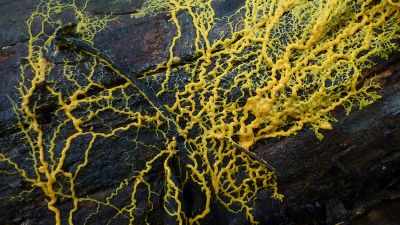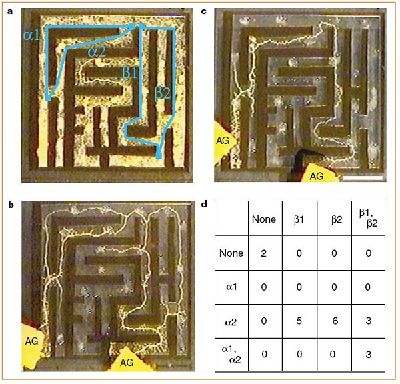GMU:DIY Biolab “Driver’s License”/Jiannan Zhang/1.Project introduction: Difference between revisions
No edit summary |
|||
| Line 11: | Line 11: | ||
They feed on microorganisms that live in any type of dead plant material. They contribute to the decomposition of dead vegetation, and feed on bacteria, yeasts, and fungi. For this reason, slime molds are usually found in soil, lawns, and on the forest floor, commonly on deciduous logs. However, in tropical areas they are also common on inflorescences and fruits, and in aerial situations (e.g., in the canopy of trees). In urban areas, they are found on mulch or even in the leaf mold in rain gutters, and also grow in air conditioners, especially when the drain is blocked. | They feed on microorganisms that live in any type of dead plant material. They contribute to the decomposition of dead vegetation, and feed on bacteria, yeasts, and fungi. For this reason, slime molds are usually found in soil, lawns, and on the forest floor, commonly on deciduous logs. However, in tropical areas they are also common on inflorescences and fruits, and in aerial situations (e.g., in the canopy of trees). In urban areas, they are found on mulch or even in the leaf mold in rain gutters, and also grow in air conditioners, especially when the drain is blocked. | ||
[[File:slime mold.jpg|400px]] | |||
A very well-known feature of slime mold is the remarkable ‘intelligence’ it shows to adapt itself rapidly to a living environment. In many researches, scientists and curious students proved that by utilizing this function, slime mold can even solve many difficult problems, which usually take much more time for humans to do so. | A very well-known feature of slime mold is the remarkable ‘intelligence’ it shows to adapt itself rapidly to a living environment. In many researches, scientists and curious students proved that by utilizing this function, slime mold can even solve many difficult problems, which usually take much more time for humans to do so. | ||
One example would be the famous maze puzzle experiment did by Dr. Nagakaki and his associates in Japan. (Link to the video: https://youtu.be/lls27hu03yw) | One example would be the famous maze puzzle experiment did by Dr. Nagakaki and his associates in Japan. (Link to the video: https://youtu.be/lls27hu03yw) | ||
[[File:puzzle experiment.jpg|400px]] | |||
If the organism is chopped up and dropped into a labyrinth (a maze), they put themselves back together and start to move. At the same time, if a food source is placed at the entrance and exit to the maze, they avoid dead ends in the maze and form a connection (as a single tube) between the food sources. In all cases, the organism chose the path that was the shortest between the two food sources. In a way, it "solved" the puzzle of finding the shortest path through the maze. | If the organism is chopped up and dropped into a labyrinth (a maze), they put themselves back together and start to move. At the same time, if a food source is placed at the entrance and exit to the maze, they avoid dead ends in the maze and form a connection (as a single tube) between the food sources. In all cases, the organism chose the path that was the shortest between the two food sources. In a way, it "solved" the puzzle of finding the shortest path through the maze. | ||
Revision as of 19:10, 30 January 2018
1.1 Abstract
This log recorded the process of experimenting with an one cellular organism ‘slime molds’ to build a three dimensional glass art installation. The idea was inspired by the movie ‘Life’, which advocates people to have respect and fear for all creatures or they will be destroyed by their arrogance and ignorance. The experiments are mainly about trying to awake the organism and observe the survival conditions of it. I collected samples and regrow them in petri dishes under different kinds of living environment. The experiment results were not satisfying but I concluded several potential reasons for why the organism didn’t grow well.
1.2 Idea development
Slime mold or slime mould is an informal name given to several kinds of unrelated eukaryotic organisms that can live freely as single cells, but can aggregate together to form multicellular reproductive structures.
They feed on microorganisms that live in any type of dead plant material. They contribute to the decomposition of dead vegetation, and feed on bacteria, yeasts, and fungi. For this reason, slime molds are usually found in soil, lawns, and on the forest floor, commonly on deciduous logs. However, in tropical areas they are also common on inflorescences and fruits, and in aerial situations (e.g., in the canopy of trees). In urban areas, they are found on mulch or even in the leaf mold in rain gutters, and also grow in air conditioners, especially when the drain is blocked.
A very well-known feature of slime mold is the remarkable ‘intelligence’ it shows to adapt itself rapidly to a living environment. In many researches, scientists and curious students proved that by utilizing this function, slime mold can even solve many difficult problems, which usually take much more time for humans to do so.
One example would be the famous maze puzzle experiment did by Dr. Nagakaki and his associates in Japan. (Link to the video: https://youtu.be/lls27hu03yw)
If the organism is chopped up and dropped into a labyrinth (a maze), they put themselves back together and start to move. At the same time, if a food source is placed at the entrance and exit to the maze, they avoid dead ends in the maze and form a connection (as a single tube) between the food sources. In all cases, the organism chose the path that was the shortest between the two food sources. In a way, it "solved" the puzzle of finding the shortest path through the maze.

